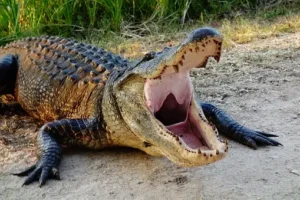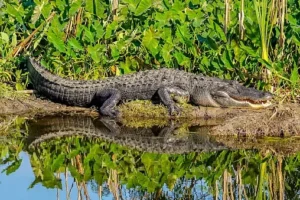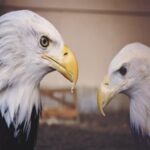Introduction to Alligators:

Alligators, belonging to the family Alligatoridae, are formidable reptiles known for their ancient lineage and distinct features. These large, semi-aquatic creatures have captured human fascination for centuries due to their unique biology, behaviors, and historical significance. They are native to the southeastern United States and China, inhabiting a range of wetland ecosystems from swamps and marshes to rivers and lakes.
One of the most striking characteristics of alligators is their physical appearance. They possess a powerful body covered in tough, armored skin that is often dark green to black in color, allowing them to blend seamlessly into their watery environments. Their muscular tails are well-adapted for aquatic propulsion, enabling them to move gracefully through water while also serving as a potent weapon against threats.
The facial features of alligators are equally remarkable. Their broad snouts and upward-facing nostrils distinguish them from their close relatives, the crocodiles, which have narrower snouts. This anatomical difference reflects their distinct ecological adaptations. They are cold-blooded reptiles, relying on external sources of heat to regulate their body temperature, and they are most active during warm weather.
These reptiles play a crucial role in their ecosystems as apex predators. Their diet primarily consists of fish, birds, mammals, and amphibians, and they often lurk at the water’s edge, utilizing their stealth and powerful jaws to ambush unsuspecting prey. Alligators’ powerful bite, aided by sharp teeth, makes them efficient hunters and scavengers.
The life cycle of an alligator is a testament to their resilience. Females construct nests and lay eggs in mounds of vegetation, and after an incubation period, hatchlings emerge. These vulnerable young alligators face numerous challenges, including predation and environmental hazards, as they grow and develop into formidable adults.
In recent decades, their conservation has gained prominence due to habitat loss and human interactions. These reptiles are now protected in many areas to ensure their survival and the maintenance of healthy wetland ecosystems. Despite their fearsome reputation, they are a vital part of the natural world, showcasing the intricate balance of life in the wild.
Physical Characteristics:

They are remarkable reptiles known for their distinct physical characteristics that enable them to thrive in their aquatic environments. These creatures belong to the family Alligatoridae and are known for their close resemblance to crocodiles, yet they possess unique features that set them apart.
Size is one of the most notable aspects of alligators. They exhibit sexual dimorphism, with males generally growing larger than females. Adult American alligators , for instance, can reach lengths of up to 13 to 15 feet (4 to 4.5 meters), while Chinese alligators (Alligator synesis) are smaller, usually around 6 to 7 feet. Their sturdy bodies are covered in armored skin made up of bony plates called scots. These scots provide protection and contribute to their streamlined appearance.
They have a distinctive broad, rounded snout that sets them apart from crocodiles, whose snouts are more V-shaped. This snout morphology is linked to their diet; alligators primarily feed on fish, turtles, birds, and mammals, and their snouts are well-suited for capturing and consuming prey.
Their eyes and nostrils are situated on top of their heads, allowing them to submerge most of their bodies underwater while still observing their surroundings and breathing. When submerged, a transparent membrane covers their eyes, providing underwater vision. This adaptation is particularly useful for ambush-style hunting.
Furthermore, alligators possess powerful jaws equipped with strong muscles that enable them to generate tremendous biting force. They have a remarkable ability to bite down with great strength, but their muscles for opening the jaws are comparatively weaker, making it possible for humans to hold their mouths shut with minimal effort.
The skin of alligators is not only protective but also thermoregulatory. It helps regulate their body temperature by absorbing and retaining heat from the environment, aiding in maintaining their metabolic processes.
Habitat and Distribution:

They are iconic reptiles known for their formidable presence and ancient lineage, inhabit a diverse range of aquatic environments across the southeastern United States and China. These habitats have played a pivotal role in shaping the alligator’s ecological niche and survival strategies.
In the United States, the American alligator is predominantly found in the southeastern states, including Florida, Louisiana, Georgia, Alabama, and Mississippi. They have a remarkable adaptability to various aquatic ecosystems, thriving in freshwater environments such as swamps, marshes, lakes, rivers, and even slow-moving streams. One of their most recognizable habitats is the wetlands, where they can be observed basking in the sun along the banks or submerged in shallow waters.
They are also known to modify their habitats through their behaviors. They create “gator holes” – depressions in the landscape that fill with water – during the dry season, providing essential watering holes for various aquatic species. These gator holes have a profound impact on the local ecosystem’s biodiversity and are crucial for the survival of other wildlife during times of water scarcity.
In China, the Chinese alligator occupies a more limited range, primarily in the Yangtze River basin. This species prefers slower-moving, subtropical waters, such as ponds, marshes, and small lakes. The Chinese alligator’s habitat has faced significant degradation due to human activities, leading to its classification as a critically endangered species.
The distribution of alligators is closely tied to factors such as temperature, water availability, and suitable nesting sites. Their distributional patterns also reflect the historical changes in habitats due to human development and natural environmental fluctuations. Conservation efforts have been undertaken to protect and restore their habitats, as the loss of these areas can have cascading effects on both the alligator populations and the broader ecosystems they inhabit.
Mammoth: 10 Amazing Things We Should Know
Behavior and Lifecycle:

Alligators, belonging to the reptilian order Crocodilian, exhibit a fascinating range of behaviors and undergo a complex lifecycle that has captivated the interest of scientists and nature enthusiasts alike. From their social interactions to their developmental stages, alligators’ behavior and lifecycle are both intriguing and essential to understanding their role in the ecosystem.
Behavior:
They are semi-aquatic predators known for their solitary nature. They tend to inhabit freshwater environments such as swamps, marshes, lakes, and slow-moving rivers. While they are generally solitary, some social behaviors are observed, especially during the breeding season. Alligators communicate through vocalizations, body language, and even infrasound vibrations, which are particularly useful in low-frequency underwater environments.
They are cold-blooded animals, which means their body temperature depends on their environment. This thermoregulation affects their activity levels, with higher temperatures promoting increased movement and feeding. They are opportunistic feeders, preying on a variety of animals, including fish, birds, mammals, and other aquatic creatures. Their hunting strategy involves stealth and ambush, relying on their powerful jaws to capture and incapacitate prey.
Lifecycle:
The lifecycle of alligators consists of several distinct stages, each with its own characteristics and challenges:
- Egg Stage: Female alligators build nests from vegetation and mud, where they lay their eggs. The temperature during incubation determines the sex of the hatchlings, with warmer temperatures leading to males and cooler temperatures producing females.
- Hatchling Stage: Once hatched, the young alligators are extremely vulnerable. They have distinctive yellow stripes that help camouflage them in the vegetation. During this stage, they stay close to the mother for protection.
- Juvenile Stage: As they grow, young alligators venture further from the mother, honing their hunting skills and developing their independence. This stage is critical for survival, as they learn to navigate their environment and evade potential predators.
- Subadult and Adult Stages: With age, alligators become more solitary. They continue to grow, with males typically reaching larger sizes than females. Sexual maturity is reached at around 6 to 10 years for males and 10 to 20 years for females. Breeding season prompts temporary social gatherings, during which territorial disputes and courtship behaviors occur.
Diet and Feeding Habits:

Alligators, formidable predators with a lineage tracing back to the age of dinosaurs, exhibit fascinating dietary preferences and feeding behaviors that have evolved over millions of years. As semi-aquatic reptiles, alligators play a crucial role in maintaining the balance of their ecosystems by regulating prey populations and shaping the structure of their food web.
The diet of alligators is diverse, varying based on their age, size, and habitat. Young alligators primarily feed on insects, small fish, and amphibians, gradually transitioning to larger prey as they grow. Adults, with their imposing size and powerful jaws, have a more extensive diet, which often includes fish, turtles, waterfowl, and mammals like muskrats and deer. Their diet can even encompass carrion, as they are opportunistic feeders that scavenge when the chance arises.
They employ various hunting strategies, utilizing their stealth and ambush capabilities. Their anatomy facilitates efficient underwater hunting, with eyes and nostrils positioned on top of their heads, enabling them to remain almost entirely submerged while observing their surroundings. During their stealthy approach, only their eyes and nostrils break the water’s surface, making them difficult to detect by unsuspecting prey.
The feeding process of an alligator is a remarkable spectacle. When hunting, alligators burst out of the water with astonishing speed, using their strong tails for propulsion. This explosive movement propels their large bodies partially out of the water, allowing them to seize prey near the water’s edge or even catch birds perching above the surface. Their formidable jaws snap shut with tremendous force, exerting a crushing pressure that renders their prey immobile.
The role of alligators in their ecosystem is significant. By regulating prey populations, they prevent overpopulation of certain species that could disrupt the balance of their habitat. Furthermore, their feeding activities create aquatic microhabitats through the accumulation of food scraps, contributing to the diversity of the environment.
Conservation Status:
The conservation status of alligators, specifically the American alligator, has witnessed significant improvements over the past few decades. Once facing the brink of extinction, these reptiles have experienced a notable recovery owing to concerted conservation efforts, legal protection, and habitat management.
In the mid-20th century, alligator populations were severely threatened due to habitat destruction, unregulated hunting, and a thriving trade in their hides. As a response to this decline, the U.S. Fish and Wildlife Service listed the American alligator under the Endangered Species Act in 1967. This move marked a turning point, leading to the implementation of conservation strategies that aimed to protect their habitats, control hunting, and monitor populations.
Thanks to these conservation measures, the American alligator’s status has improved dramatically. The population rebound has been particularly noticeable in the southeastern United States, their primary habitat. Wetland protection and restoration efforts, such as the creation of wildlife refuges and protected reserves, have provided safer havens for these reptiles. Additionally, regulated hunting programs have been established to sustainably manage alligator populations and provide economic incentives for local communities.
As of today, the American alligator has been removed from the Endangered Species List due to its successful recovery. It is now classified as a species of “Least Concern” by the International Union for Conservation of Nature (IUCN). However, it’s important to note that conservation efforts must remain ongoing to ensure the continued well-being of alligator populations. Human activities, urbanization, and climate change still pose challenges to their habitats and survival.
Interactions with Humans:

Interactions between alligators and humans have long captured attention due to their potential risks and the unique aspects of coexisting with these ancient reptiles. They are primarily found in freshwater habitats across the southeastern United States, and as urbanization encroaches upon their natural habitats, encounters with humans have become more frequent. These interactions can be categorized into various aspects.
1. Safety Concerns: They attacks on humans, while rare, do occur. They are opportunistic predators and can be dangerous if approached or provoked. Instances of alligator attacks have led to increased awareness about safety guidelines when living or recreating in areas inhabited by these reptiles.
2. Wildlife Management: In regions where alligators and humans share habitats, wildlife management agencies play a crucial role. They monitor alligator populations, relocate them from high-risk areas to safer habitats, and occasionally euthanize alligators that pose immediate threats to public safety.
3. Tourism and Education: They often serve as tourist attractions, drawing people to zoos, wildlife sanctuaries, and eco-tours. These settings provide educational opportunities to learn about alligator biology, behavior, and conservation, fostering a deeper understanding of these creatures.
4. Habitat Protection and Restoration: As awareness grows about the importance of preserving natural habitats, efforts to protect and restore wetlands benefit not only alligators but also other species that depend on these ecosystems. Human activities can disrupt these habitats, leading to decreased alligator populations.
5. Legal Protection: In many places, They are legally protected due to their ecological importance. Regulations restrict hunting, poaching, and trading in alligator products, which were once common practices that led to population declines.
6. Urbanization and Human Expansion: The expansion of human populations into alligator habitats can lead to conflicts. Drainage of wetlands, construction of homes near water bodies, and alterations to water flow can force alligators to interact more closely with humans.
Cultural Significance:
They hold a distinct and multifaceted cultural significance in various societies across the world. Revered and sometimes feared, these reptiles have woven themselves into the fabric of human imagination, folklore, and symbolism.
In many indigenous cultures of the Americas, alligators have been viewed with both awe and respect. They often symbolize strength, adaptability, and a deep connection to the natural world. Native American tribes, particularly those in the southeastern United States, have integrated alligators into their creation stories, often portraying them as powerful and spiritual beings. These stories emphasize the balance between humans and nature, teaching lessons about the importance of coexistence.
The Nile crocodile, a close relative of the alligator, has held significant cultural and religious importance in ancient Egyptian culture. Depicted in hieroglyphs and art, crocodiles symbolized the dangerous forces of nature that needed to be appeased and respected. They were associated with Sobek, the crocodile-headed god, who represented protection, fertility, and power.
In modern times, alligators have found their way into pop culture, literature, and art. They are frequently portrayed in movies, television shows, and books as formidable predators, often enhancing the sense of danger and adventure. This portrayal has contributed to the mystique and allure associated with alligators.
Furthermore, the alligator is a symbol of resilience in regions where they thrive. In the southern United States, especially in states like Florida and Louisiana, they are emblematic of the wild and untamed aspects of the swampy landscapes. They are featured in local festivals, sports team mascots, and even on license plates, showcasing their integral role in regional identity.
The leather industry has also utilized alligator hides for luxury goods, further enhancing their economic value and cultural significance. However, this practice has raised ethical concerns, leading to debates about conservation and sustainable use.
Aldabra Giant Tortoise: 15 Most Useful Points
Research and Study:
The study of their encompasses a wide range of scientific investigations that contribute to our understanding of their biology, behavior, ecology, and role within ecosystems. Researchers have been drawn to alligators due to their unique characteristics and their position as top predators in their habitats. Here are some key aspects of research and study related to alligators:
- Ecology and Habitat: Scientists study the habitats where alligators thrive, including wetlands, swamps, rivers, and lakes. This research helps in understanding their interactions with other species and their adaptations to specific environments.
- Behavioral Studies: Research into alligator behavior includes studies of courtship, nesting, territoriality, communication, and social interactions. Such studies reveal insights into their complex social structures and mating rituals.
- Lifecycle and Reproduction: Understanding the reproductive biology of alligators involves studying their nesting habits, incubation, and the early stages of hatchlings’ lives. Researchers investigate the factors affecting hatchling survival and growth rates.
- Feeding Ecology: Examining their diets and feeding behavior helps elucidate their role in maintaining ecosystem balance. These studies often involve analyzing stomach contents and tracking feeding patterns.
- Physiology and Anatomy: Researchers delve into the physiological aspects of alligators, including their thermoregulation mechanisms, cardiovascular systems, and sensory organs. Comparative anatomy studies shed light on their evolutionary adaptations.
- Conservation Efforts: Research plays a vital role in developing conservation strategies for alligator populations. By monitoring populations, understanding migration patterns, and identifying threats, scientists help implement effective conservation measures.
- Human-Wildlife Interactions: Understanding the interactions between alligators and humans is crucial for safety and coexistence. Research in this area provides insights into alligator behavior in urban environments and informs guidelines for managing human encounters.
- Paleontology and Evolution: They are ancient reptiles with a rich evolutionary history. Paleontologists study fossil records to trace their lineage, gaining insights into the prehistoric ecosystems they inhabited.
- Climate Change Impact: Research is being conducted to assess how climate change affects alligator habitats, behavior, and distribution. Understanding these impacts aids in predicting future trends and potential challenges.
- Educational Outreach: Their research often extends to educational outreach programs, where researchers engage with the public, sharing knowledge about these reptiles’ importance and dispelling myths.
Comparisons with Crocodiles:
They and crocodiles are two distinct species within the order Crocodilian, sharing a common lineage but exhibiting notable differences in terms of physical characteristics, behavior, habitat preferences, and geographic distribution. Here, we highlight key points of comparison between these two reptilian predators:
1. Physical Characteristics:
They typically have a broader, U-shaped snout, while crocodiles tend to have a V-shaped snout. They are generally darker in color and have a more robust build, while crocodiles are lighter and more streamlined.
2. Habitat Preferences:
They are predominantly found in freshwater habitats like swamps, marshes, and slow-moving rivers. Crocodiles, on the other hand, are more adaptable and can inhabit a wider range of environments, including freshwater, brackish water, and saltwater habitats.
3. Geographic Distribution:
They are primarily native to the southeastern United States and China. Crocodiles have a broader distribution, spanning regions in Africa, Asia, the Americas, and Australia.
4. Behavior and Temperament:
They are generally less aggressive than crocodiles. Crocodiles are known to be more territorial and aggressive, often displaying higher levels of aggression towards each other and other species.
5. Saltwater Tolerance:
Crocodiles have specialized salt glands that allow them to excrete excess salt, enabling them to inhabit saltwater environments. They lack these glands and are primarily found in freshwater habitats.
6. Vocalizations:
Both species produce distinct vocalizations, but the sounds differ. They produce a deep, low-frequency bellowing noise, while crocodiles emit a range of vocalizations including hisses and more varied roars.
7. Nesting Behavior:
They build mound nests out of vegetation and mud, often in areas with warmer temperatures. Crocodiles construct more structured and elevated nests using sticks and vegetation, which are better suited to protect their eggs from flooding and predators.
8. Conservation Status:
Both species have experienced threats due to habitat loss, hunting, and human-wildlife conflicts. Some crocodile species are more critically endangered than alligator species due to variations in their habitats and distributions.
9. Reproductive Differences:
Female crocodiles are known for being more attentive mothers, guarding their nests and assisting hatchlings. Female are more focused on protecting the nest, but they do not exhibit the same level of maternal care once the eggs hatch.
10. Size Variations:
Crocodiles tend to be larger overall, with some species reaching lengths of up to 20 feet or more. They are generally smaller, with the largest individuals reaching around 14 feet.
FAQ’s:
What is an alligator?
An alligator is a large reptile belonging to the Alligatoridae family. It is characterized by a broad snout, powerful jaws, and a bony plate on its forehead. They are semi-aquatic and primarily inhabit freshwater environments such as swamps, marshes, and rivers.
How do alligators differ from crocodiles?
They and crocodiles are both reptiles, but they belong to different families. One key difference is in their snouts: alligators have a wider, U-shaped snout, while crocodiles have a V-shaped snout. Additionally, when an alligator’s mouth is closed, its upper teeth are hidden, while in a crocodile, both upper and lower teeth are visible.
What do alligators eat?
They are carnivores and primarily feed on a diet of fish, birds, amphibians, and mammals. They are opportunistic predators and use their powerful jaws to catch and consume their prey. They often lie in wait near the water’s edge, using stealth to ambush their unsuspecting prey.
Are alligators dangerous to humans?
They can be dangerous to humans if they feel threatened or provoked. While attacks on humans are relatively rare, they can occur, especially in areas where humans and alligators come into close contact. It’s important to exercise caution around alligators and avoid feeding them, as this can lead to them associating humans with food.
How do alligators survive in cold weather?
They are ectothermic animals, meaning they rely on external sources of heat to regulate their body temperature. In colder weather, they enter a state of decreased activity known as brumation, which is similar to hibernation. They seek out warmer spots in the water or burrow into mud to conserve energy until temperatures rise again.


